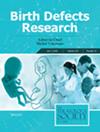Prenatal exposure to pesticide mixture in Argentina: A pilot study in puerperal women from Santa Fe province
Abstract
Introduction
The epidemiological investigation of congenital anomalies (CA) represents a challenge due to the multiplicity of associated risk factors, notably environmental ones. The monitoring of genotoxic effects in different populations is a useful tool in human biomonitoring and has great biological importance in estimating the exposure risks to complex mixtures of chemical substances.
Objective
This study aimed to determine the presence of environmental xenobiotics and evaluate their genotoxic effect, in mothers of newborns with and without CA, and the possible association/correlation between those biomarkers and CA.
Materials and methods
A descriptive case and control cross-sectional study was developed on 290 postpartum women from Santa Fe, Argentina.
Results
Significant differences were observed between both groups, for places of residence and gynecological variables. Metabolites of organochlorine (OC), organophosphate (OP), and pyrethroid (PYR) pesticides were detected. The most frequently detected compounds were atrazine (ATZ) (57.14%), carbendazim (CBZ) (46.42%), and methylparaben (46.42%), among others. A positive correlation was found between the number of pesticides in blood and genotoxic variables. On the other hand, mothers of children with genitourinary anomalies were the ones with the highest concentrations of ATZ and OP.
Discussion and conclusion
These results showed a deep background in the health reality of Santa Fe, which could greatly impact the health of future adults, who have been born preterm. On the other hand, the mixture of pesticides detected confirms the environmental living conditions of women and the transplacental exposure to these compounds in each pregnancy. The potential effects on long-term descendent health are unknown and unpredictable.

 求助内容:
求助内容: 应助结果提醒方式:
应助结果提醒方式:


